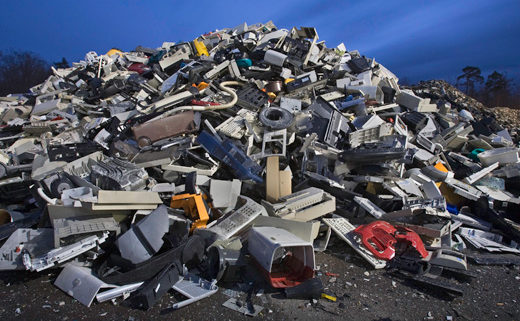Our beautiful, fragile world: Peter Essick’s haunting portrait of 21st century life on Earth
Peter Essick’s new book ‘Our beautiful, fragile world’ captures the human and environmental cost of humanity’s deep effect on our planet. Essick, an award-winning photojournalist who has travelled to remote locations recording environmental destruction for 25 years, has focused on a wide range of issues in his latest collection. From the Arctic to the Amazon Rainforest to the sinking islands of the Maldives, Essick takes us on a whistle-stop tour of the major environmental issues facing our society today, including climate change, deforestation, biodiversity loss, water scarcity, e-waste (or ‘high tech trash’) and plastics pollution.
Essick leaves no stone unturned in his vivid portrayal of people and nature struggling with our changing world. Despite this, he explains that his images are intended to inspire both current and future generations and help them to protect the Earth. His message is one of optimism for change and innovation, he says. In the foreword, Jean-Michel Cousteau, president of the Ocean Futures Society, echoes this sentiment, highlighting the potential for Essick’s work to shine a light on new insights that will improve our understanding of nature and ultimately help us to reverse the damage inflicted on our ecosystems.
“Peter showed true dedication to his craft during the day-long photo shoot at MBA Polymers Austria,” says MBA’s founder Mike Biddle. “He wanted to achieve the best possible shots and lighting to communicate his story. Beyond this, I’m very impressed by his book and the breadth of his work and concerns – it’s clear that we share a passion for tackling plastic waste and protecting our oceans.”
‘Modern Trash’, a selection of Essick’s pictures from around the world.
High tech trash
So how do we balance our need for technology with the avalanche of e-waste it generates? Essick highlights the error of shutting discarded electronic devices away in the attic, items that can be ‘mined’ for plastics and metals to create new materials. He tells the story of his trip to Accra, Ghana, for National Geographic magazine to capture workers picking e-waste apart in unsafe conditions using environmentally unsound techniques. Here, he saw e-waste from the U.S and Europe being illegally recycled.
Essick describes a seedy underworld with unscrupulous middlemen and workers stripping copper wire from end-of-life electronics with their bare hands. Turning the page, you see an image of a young boy carrying a huge stack of wires on his head. In a revealing conversation, the boy tells Essick that he and his family had moved to Accra due to droughts making their land impossible to farm. This image has proved to be the most requested picture of his assignment, because, Essick believes, it puts a human face on a problem that can otherwise seem distant and intangible.
Plastic pollution
In a characteristically perceptive statement, Essick describes how he quickly realised that plastic was the least ‘desirable’ e-waste material in economic terms. He saw workers in Ghana, India, and China tearing out circuit boards and copper wires, and throwing the plastic carcass of a computer into a dump or even a riverbed.
He highlights the ongoing health concerns surrounding some of the chemicals used in plastics manufacturing, and of course the incredible amount of energy it takes to make virgin plastic from crude oil. He whisks us away to the Great Pacific Garbage Patch, evoking the exceptionally high concentration of discarded plastics and chemical sludge that are slowly choking our marine life.
The plastic dilemma
Essick is a realist – he explains that despite the untold environmental damage caused by plastic pollution, plastics remain popular due to their cheap price, light weight and durability – the same characteristic that stops them from degrading in landfill or the ocean for hundreds of years. And he touches on the complexities of the sorting process and the fact that a single mobile phone can comprise a dozen different types of plastics that all need to be separated in order to be reused.
A way forward
It’s not all doom and gloom, though. In line with his vision of inspiring rather than demoralising, Essick takes us straight from children handling e-waste in the shantytowns of Ghana to MBA’s world-leading plastics recycling facility in Austria. The contrast couldn’t be more acute. Essick explains the value of our work in recycling plastics from end-of-life electronic goods using advanced technology, producing high quality recycled plastics for use in manufacturing. (For more on our Austrian facility, click here). Finally, he leaves plastics and moves to the next environmental conundrum: fertilizer use…
Let us know what you think of Essick’s work. Does it inspire you to renew your connection with the natural world? Contact us via our website or tweet us @MBAPolymersUK.
» View Modern Waste, images from ‘Our beautiful, fragile world’

